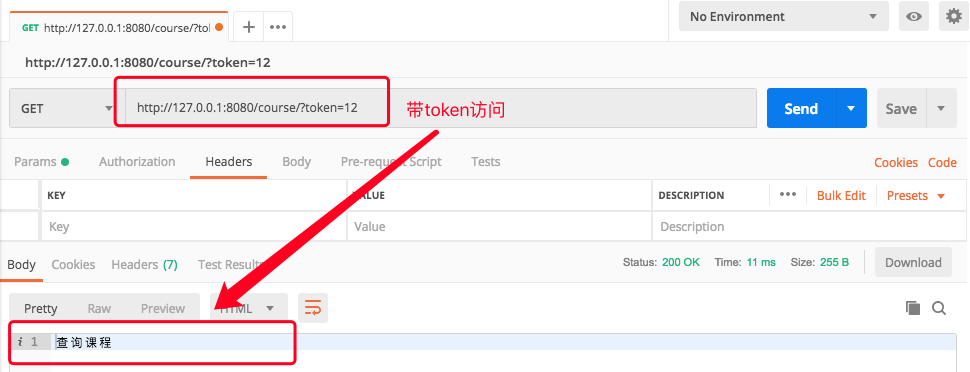django的rest framework框架——01
一、django的FBV 和 CBV
1、FBV(基於函式的檢視):
urlpatterns = [ url(r'^users/', views.users), ]
def users(request): user_list = ["amy", "jack", "lily"] return HttpResponse(json.dumps(user_list))
2、CBV(基於類的檢視):
urlpatterns = [ url(r'^students/', views.StudentsView.as_view()), ]
from django.views import View
class StudentsView(View): def get(self, request, *args, **kwargs): """get方法訪問""" return HttpResponse("get") def post(self, request, *args, **kwargs): """post方法訪問""" return HttpResponse("post") def put(self, request, *args, **kwargs):"""put方法訪問""" return HttpResponse("put") def delete(self, request, *args, **kwargs): """delete方法訪問""" return HttpResponse("delete")
3、CBV實現原理


dispatch()方法的實現相當於:
from django.views import View class StudentsView(View): def dispatch(self, request, *args, **kwargs): func= getattr(self, request.method.lower()) # 通過反射獲取請求方法(記得把獲取到的方法名變成小寫) return func(request, *args, **kwargs) # 執行這個方法並將結果返回給使用者
CBV就是通過路由,執行view()方法,再通過dispatch()方法基於反射,根據不同的請求方式來執行這些請求方法,如get、post、patch等。
若是繼承父類的dispatch方法:
class StudentsView(View): def dispatch(self, request, *args, **kwargs): # 繼承父類的dispatch方法 return super(StudentsView, self).dispatch(request, *args, **kwargs)

4、多個類繼承基類
多個類公用的功能可以用繼承來實現:

from django.views import View class MyBaseView(object): def dispatch(self, request, *args, **kwargs): # 繼承父類的dispatch方法 return super(MyBaseView, self).dispatch(request, *args, **kwargs) class StudentsView(MyBaseView, View): def get(self, request, *args, **kwargs): """get方法訪問""" return HttpResponse("get") def post(self, request, *args, **kwargs): """post方法訪問""" return HttpResponse("post") def put(self, request, *args, **kwargs): """put方法訪問""" return HttpResponse("put") def delete(self, request, *args, **kwargs): """delete方法訪問""" return HttpResponse("delete") class TeachersView(MyBaseView, View): def get(self, request, *args, **kwargs): """get方法訪問""" return HttpResponse("get") def post(self, request, *args, **kwargs): """post方法訪問""" return HttpResponse("post") def put(self, request, *args, **kwargs): """put方法訪問""" return HttpResponse("put") def delete(self, request, *args, **kwargs): """delete方法訪問""" return HttpResponse("delete")View Code

5、CBV的csrf認證
方法1:給dispatch()方法加上裝飾器,即可讓該檢視免於csrftoken認證:

import json from django.shortcuts import render, HttpResponse from django.views import View from django.views.decorators.csrf import csrf_exempt from django.utils.decorators import method_decorator class StudentsView(View): @method_decorator(csrf_exempt) def dispatch(self, request, *args, **kwargs): return super(StudentsView, self).dispatch(request, *args, **kwargs) def get(self, request, *args, **kwargs): """get方法訪問""" return HttpResponse("get") def post(self, request, *args, **kwargs): """post方法訪問""" return HttpResponse("post") def put(self, request, *args, **kwargs): """put方法訪問""" return HttpResponse("put") def delete(self, request, *args, **kwargs): """delete方法訪問""" return HttpResponse("delete")View Code
方法2:給類加上裝飾器,使得該檢視免於csrftoken認證:

from django.shortcuts import render, HttpResponse from django.views import View from django.views.decorators.csrf import csrf_exempt from django.utils.decorators import method_decorator @method_decorator(csrf_exempt, name="dispatch") class StudentsView(View): def get(self, request, *args, **kwargs): """get方法訪問""" return HttpResponse("get") def post(self, request, *args, **kwargs): """post方法訪問""" return HttpResponse("post") def put(self, request, *args, **kwargs): """put方法訪問""" return HttpResponse("put") def delete(self, request, *args, **kwargs): """delete方法訪問""" return HttpResponse("delete")View Code
二、基於Django實現restful api
1、例:訂單的增刪改查
對於普通的藉口開發:

from django.conf.urls import url from app01 import views urlpatterns = [ url(r'^get_order/', views.get_order), url(r'^del_order/', views.del_order), url(r'^add_order/', views.add_order), url(r'^update_order/', views.update_order), ]View Code

from django.shortcuts import render, HttpResponse def get_order(request): return HttpResponse("get_order") def del_order(request): return HttpResponse("del_order") def update_order(request): return HttpResponse("update_order") def add_order(request): return HttpResponse("add_order")View Code
這種方式在url比較多的情況下並不實用,所以我們引出了restful規範,根據請求方式的不同來進行不同的操作:
get請求→查詢
post請求→建立
delete請求→刪除
put請求→更新
(1)基於FBV的寫法:

from django.conf.urls import url from app01 import views urlpatterns = [ url(r'^order/', views.order), ]View Code

from django.shortcuts import render, HttpResponse from django.views.decorators.csrf import csrf_exempt @csrf_exempt def order(request): if request.method == "GET": return HttpResponse("查詢訂單") elif request.method == "POST": return HttpResponse("建立訂單") elif request.method == "DELETE": return HttpResponse("刪除訂單") elif request.method == "PUT": return HttpResponse("更新訂單")View Code
(2)基於CBV的寫法:

from django.conf.urls import url from app01 import views urlpatterns = [ url(r'^order/', views.OrderView.as_view()), ]View Code

from django.shortcuts import render, HttpResponse from django.views import View from django.views.decorators.csrf import csrf_exempt from django.utils.decorators import method_decorator @method_decorator(csrf_exempt, name="dispatch") class OrderView(View): def get(self, request, *args, **kwargs): return HttpResponse("查詢訂單") def post(self, request, *args, **kwargs): return HttpResponse("建立訂單") def delete(self, request, *args, **kwargs): return HttpResponse("刪除訂單") def put(self, request, *args, **kwargs): return HttpResponse("更新訂單")View Code
三、RESTful協議
REST與技術無關,它代表的是一種面向資源軟體架構風格,REST是Representational State Transfer的簡稱,中文翻譯為“表徵狀態轉移”。
1、API與使用者的通訊協議,總是使用https協議
2、域名
- 子域名的方式(存在跨域問題)
www.baidu.com # 使用者訪問這個 api.baidu,com # 返回json資料
- URL方式
www.baidu.com # 使用者訪問這個 www.baidu,com/aip/ # 返回json資料
3、版本
- 加到URL上:https://www.baidu.com/api/v1/
- 加到請求頭上(跨域時,會引發多次請求)
4、路徑
將網路上的一切東西都看作資源,都使用名詞表示(也可以用複數):
https://www.baidu.com/api/v1/user/
https://www.baidu.com/api/v1/users/
5、method
- GET 從伺服器取出資源(一項或多項)
- POST 在伺服器新建一個資源
- PUT 在伺服器更新資源(客戶端提供改變後的完整資源,全部更新)
- PATCH 在伺服器更新資源(客戶端提供改變後的屬性,區域性更新)
- DELETE 從伺服器刪除資源
6、過濾
https://www.baidu.com/api/v1/user/?status=1&page=2 # 表示status=1的、第2頁的使用者
7、狀態碼

200 OK - [GET]:伺服器成功返回使用者請求的資料,該操作是冪等的(Idempotent)。 201 CREATED - [POST/PUT/PATCH]:使用者新建或修改資料成功。 202 Accepted - [*]:表示一個請求已經進入後臺排隊(非同步任務) 204 NO CONTENT - [DELETE]:使用者刪除資料成功。 400 INVALID REQUEST - [POST/PUT/PATCH]:使用者發出的請求有錯誤,伺服器沒有進行新建或修改資料的操作,該操作是冪等的。 401 Unauthorized - [*]:表示使用者沒有許可權(令牌、使用者名稱、密碼錯誤)。 403 Forbidden - [*] 表示使用者得到授權(與401錯誤相對),但是訪問是被禁止的。 404 NOT FOUND - [*]:使用者發出的請求針對的是不存在的記錄,伺服器沒有進行操作,該操作是冪等的。 406 Not Acceptable - [GET]:使用者請求的格式不可得(比如使用者請求JSON格式,但是隻有XML格式)。 410 Gone -[GET]:使用者請求的資源被永久刪除,且不會再得到的。 422 Unprocesable entity - [POST/PUT/PATCH] 當建立一個物件時,發生一個驗證錯誤。 500 INTERNAL SERVER ERROR - [*]:伺服器發生錯誤,使用者將無法判斷髮出的請求是否成功。 更多看這裡:http://www.w3.org/Protocols/rfc2616/rfc2616-sec10.html常見狀態碼
例:
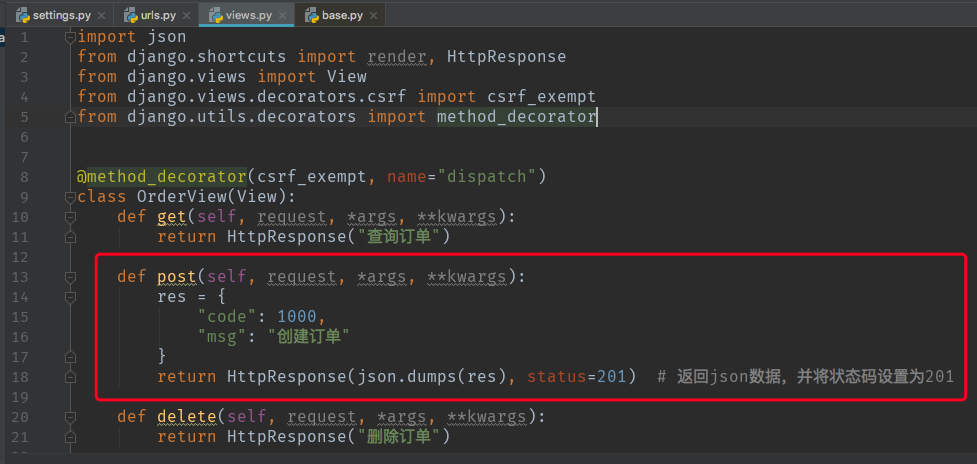
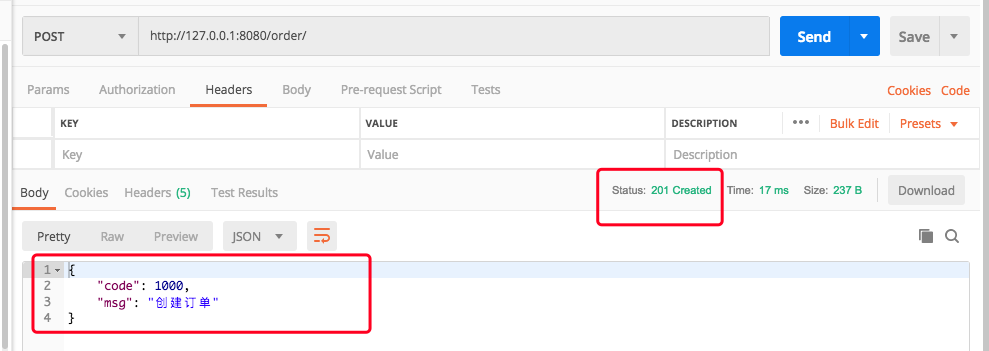
8、錯誤處理
狀態碼為4xx時,應返回錯誤資訊:
{ error: "Invalid API key" }
9、返回結果
根據不同的操作,返回不同的結果:

GET /order/:返回所有訂單列表(陣列) GET /order/1/:返回單個訂單的詳細資訊(資源物件) POST /order/:返回新生成的訂單 PUT /order/1/:返回修改後完整的訂單資訊 PATCH /order/1/:返回修改後的訂單資訊(區域性) DELETE /oder/1/:刪除訂單 返回一個空文件常用規範示例
10、Hypermedia API
在返回結果中提供連結,連向其他API方法,使得使用者不用查文件,通過這個連結來獲取資料

四、Django rest framework框架
1、安裝
pip3 install djangorestframework
2、Django rest framework認證原始碼及實現
rest_framework的dispatch方法:
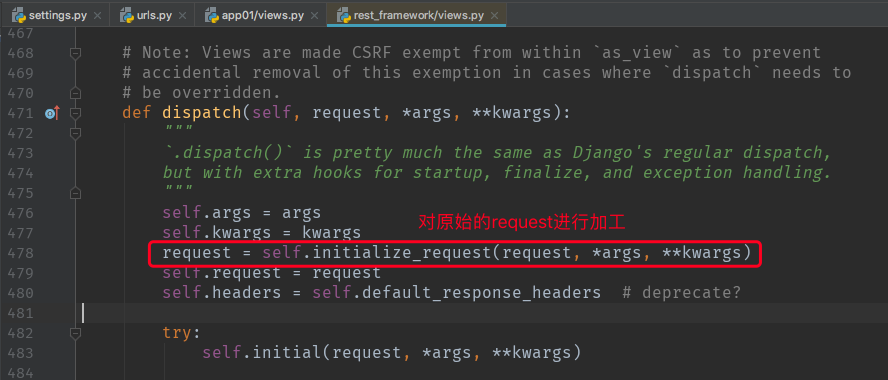
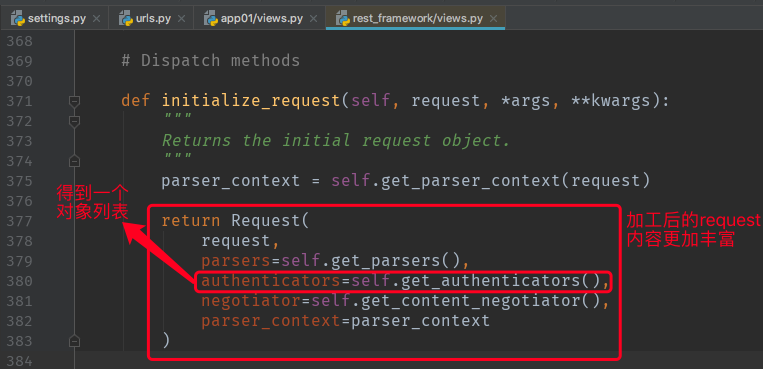

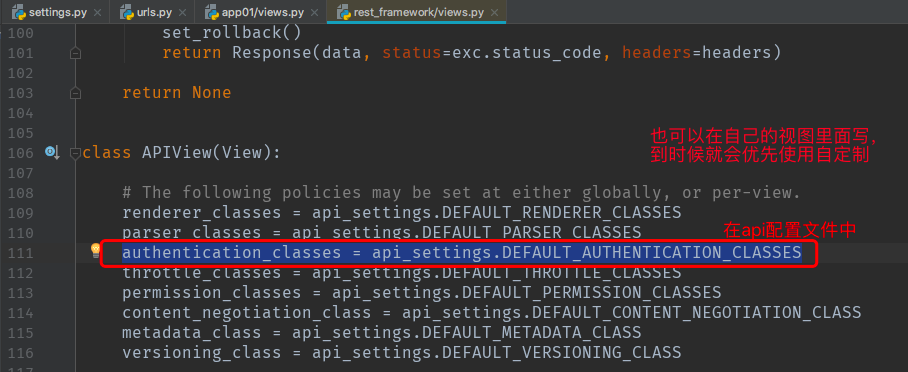
如何獲取加工後的request的值:

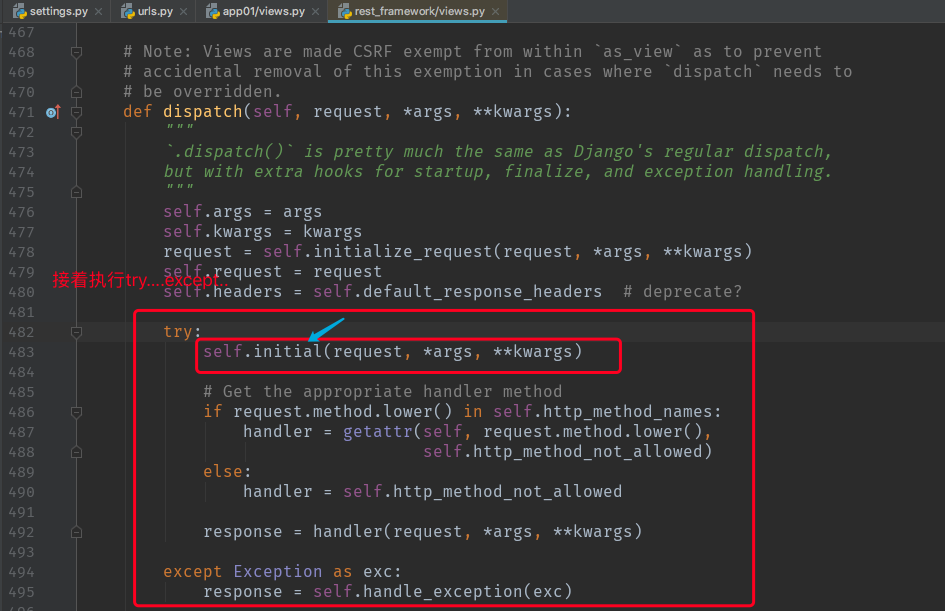
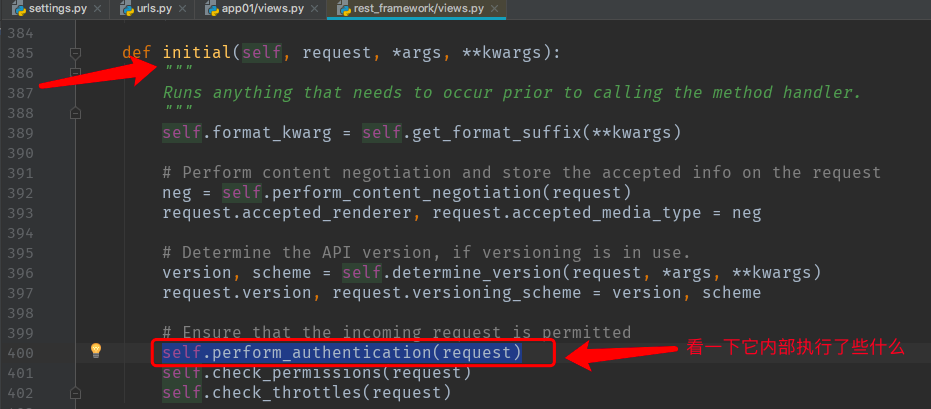
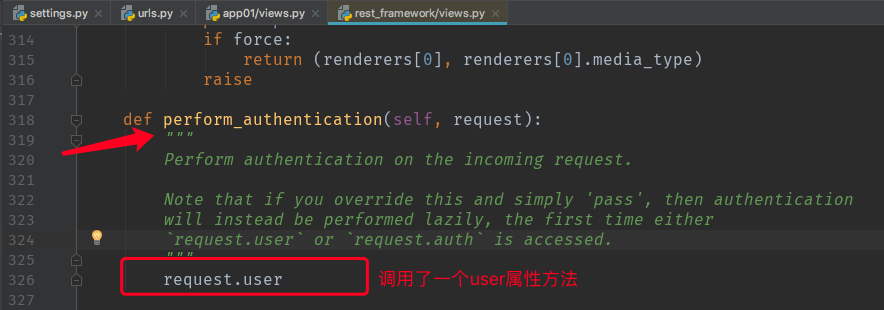
到這個加工過的Request裡面去看看user都幹了些什麼:

實現認證:

可以自定製認證類:

from django.conf.urls import url from app01 import views urlpatterns = [ url(r'^course/', views.CourseView.as_view()), ]urls.py

from django.shortcuts import render, HttpResponse from django.views import View from django.views.decorators.csrf import csrf_exempt from django.utils.decorators import method_decorator from rest_framework.views import APIView from rest_framework.authentication import BasicAuthentication from rest_framework import exceptions class MyAuthentication(object): """自定製認證""" def authenticate(self, request): # 去請求裡面獲取資訊,到資料庫中進行校驗,如果校驗失敗就丟擲異常 token = request._request.GET.get("token") if not token: raise exceptions.AuthenticationFailed("使用者認證失敗") return ("amy", None) def authenticate_header(self, val): pass @method_decorator(csrf_exempt, name="dispatch") class CourseView(APIView): authentication_classes = [MyAuthentication] # 使用自定義的 authentication_classes def get(self, request, *args, **kwargs): print(request.user) # 列印 amy return HttpResponse("查詢課程") def post(self, request, *args, **kwargs): return HttpResponse("建立課程") def delete(self, request, *args, **kwargs): return HttpResponse("刪除課程") def put(self, request, *args, **kwargs): return HttpResponse("更新課程")views.py

